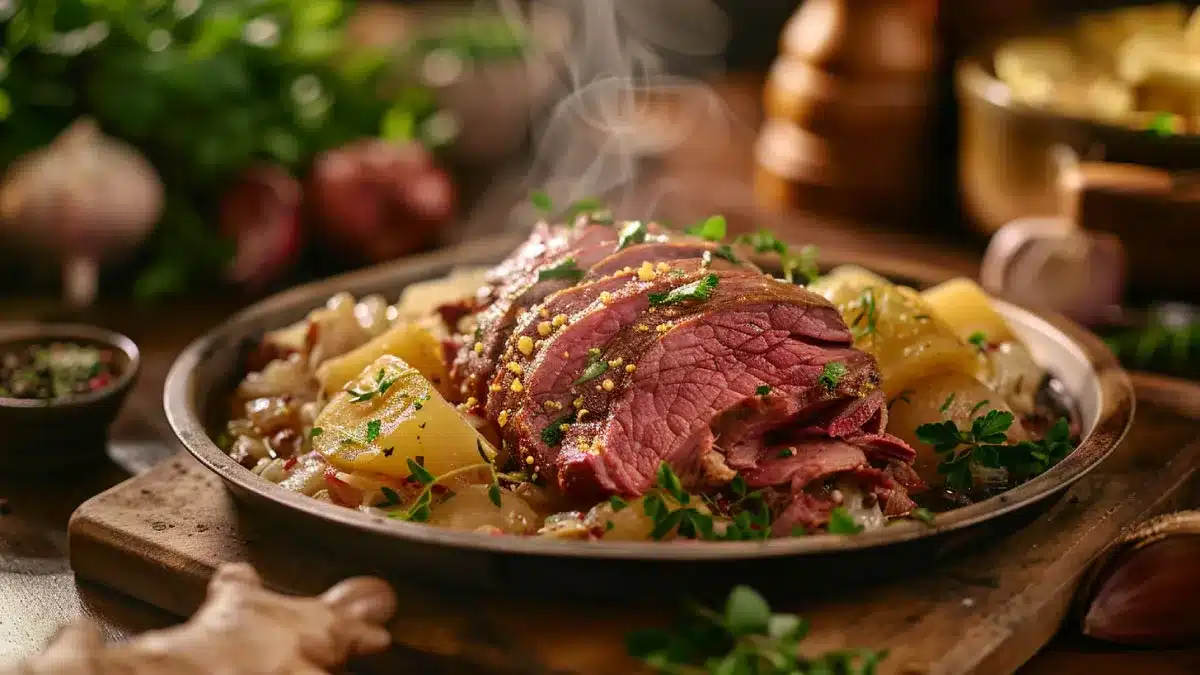Amazing Angus Corned Beef: A Complete Guide to Recipes, History, and Nutrition
When it comes to hearty, flavorful meals, few dishes can compete with Angus corned beef. This beloved dish has a rich history, a unique preparation process, and a versatility that makes it a favorite in kitchens worldwide. Whether you’re a seasoned chef or a home cook looking to try something new, this guide will walk you through everything you need to know about Angus corned beef.
From its origins to its nutritional value, cooking tips, and even global adaptations, we’ve got you covered. You’ll also find answers to common questions, a breakdown of its ingredients, and creative ways to incorporate it into your meals. So, let’s dive right in and discover why Angus corned beef deserves a spot on your table.
Table of Contents
What is Angus Corned Beef?
The Origins of Angus Corned Beef
Angus corned beef has a fascinating history that dates back centuries. The term “corned” comes from the large salt crystals, or “corns,” used to cure the beef. This method was developed as a way to preserve meat before modern refrigeration. Over time, it became a staple in many cultures, especially in Ireland and the United States.
What sets Angus corned beef apart is the use of Angus beef, known for its superior marbling and rich flavor. This high-quality beef takes the traditional corned beef recipe to a whole new level, making it a favorite for special occasions and everyday meals alike.
How Angus Corned Beef is Made
The process of making the recipe is both an art and a science. It starts with a cut of Angus beef brisket, which is then cured in a brine solution. The brine typically includes salt, water, and a mix of spices like peppercorns, mustard seeds, and bay leaves. These ingredients work together to infuse the meat with flavor while preserving it.
After curing, the beef is slowly cooked until it becomes tender and juicy. The result is a dish that’s packed with flavor and perfect for a variety of recipes. Compared to regular corned beef, Angus corned beef stands out for its richer taste and melt-in-your-mouth texture.
Ingredients and Nutrition
Key Ingredients
The magic of Angus corned beef lies in its simple yet flavorful ingredients. Here’s a breakdown of what goes into making this delicious dish:
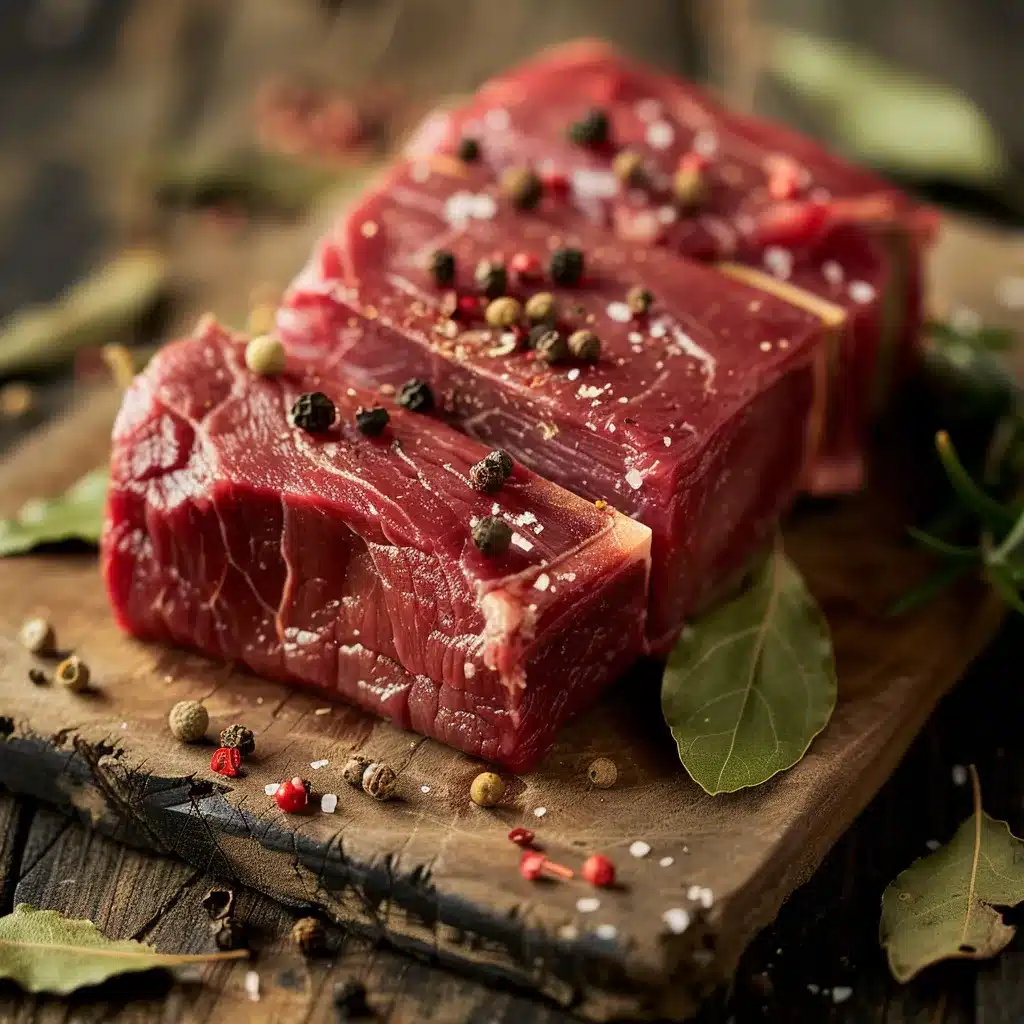
| Ingredient | Purpose |
|---|---|
| Angus beef brisket | Main protein source, rich in flavor. |
| Salt | Preserves and enhances taste. |
| Spices (e.g., peppercorns, bay leaves) | Adds depth and aroma. |
| Water | Base for brine solution. |
The Angus beef brisket is the star of the show, known for its tenderness and marbling. The salt and spices not only preserve the meat but also give it that signature tangy, savory flavor. Together, these ingredients create a dish that’s both hearty and satisfying.
Nutritional Value
When it comes to nutrition, Angus corned beef offers a mix of benefits and considerations. On one hand, it’s a great source of protein, which helps build and repair muscles. It also contains essential vitamins like B12 and minerals such as zinc and iron.
However, it’s important to note that Angus corned beef can be high in sodium due to the curing process. For those watching their salt intake, moderation is key. Pairing it with fresh vegetables or whole grains can help balance the meal. Compared to other beef products, Angus corned beef stands out for its rich flavor and versatility, making it a worthwhile addition to your diet when enjoyed responsibly.
Cooking with Angus Corned Beef
Classic Recipes
If you’re new to cooking Angus corned beef, starting with a classic recipe is a great idea. One of the most popular ways to prepare it is by boiling it with cabbage, carrots, and potatoes. This method brings out the meat’s natural flavors and creates a comforting, one-pot meal.
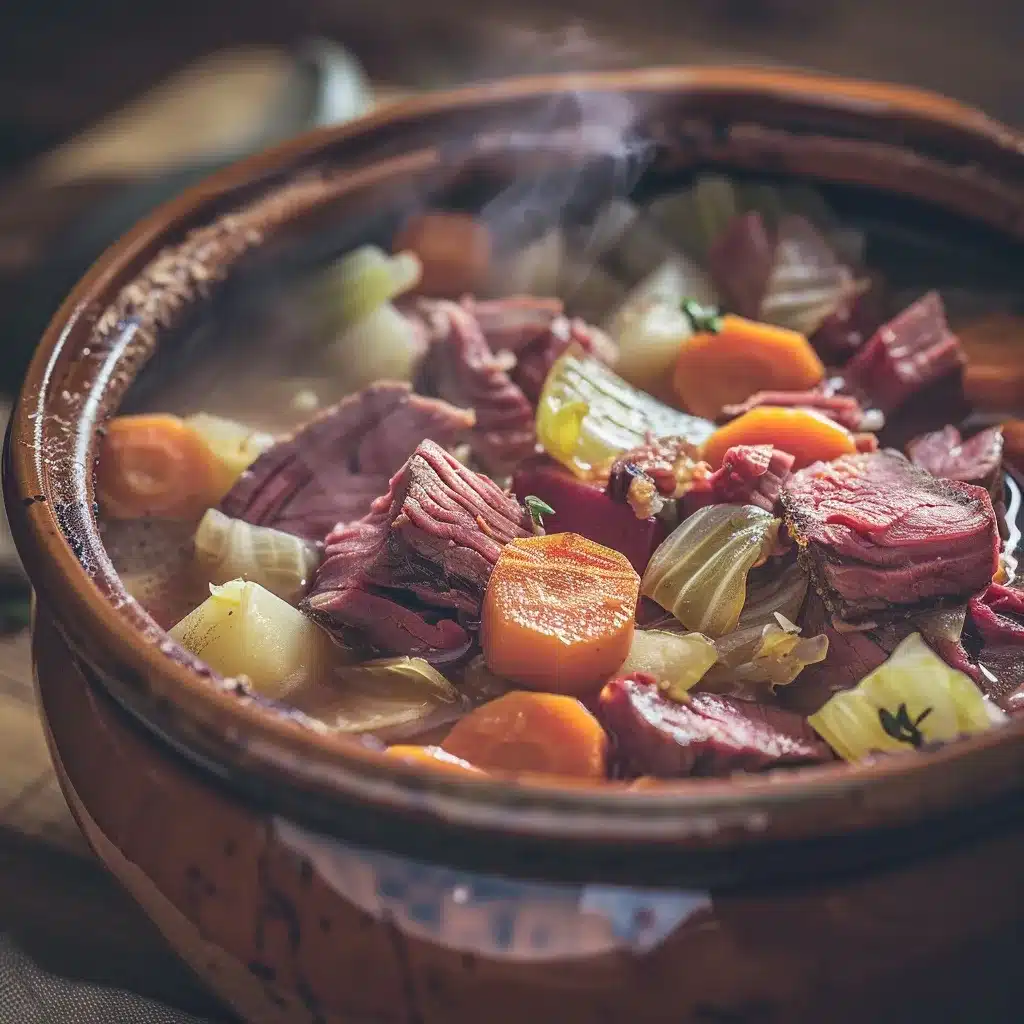
Another favorite is the slow-cooker method. Simply place the recipe in your slow cooker with some broth, spices, and vegetables. Let it cook on low for several hours, and you’ll end up with tender, fall-apart meat that’s perfect for sandwiches or salads.
Creative Ways to Use Angus Corned Beef
Once you’ve mastered the basics, it’s time to get creative. Angus corned beef can be used in a variety of dishes beyond the traditional boiled dinner. For breakfast, try making a hearty corned beef hash by frying diced potatoes, onions, and chopped Angus corned beef until crispy. Top it with a fried egg for a satisfying start to your day.
For lunch, Angus corned beef makes an excellent filling for sandwiches and wraps. Pair it with sauerkraut, Swiss cheese, and a drizzle of mustard for a classic Reuben sandwich. You can also add it to soups and stews for an extra boost of flavor and protein.
Tips for Perfectly Cooking
Cooking it to perfection requires a few key tips. First, always rinse the meat before cooking to remove excess salt from the curing process. Next, cook it low and slow to ensure it stays tender. Whether you’re boiling, slow-cooking, or baking, patience is key.
When pairing Angus corned beef with sides, opt for fresh, crisp vegetables to balance its richness. A tangy mustard sauce or horseradish cream can also add a nice contrast to the meat’s savory flavor. With these tips, you’ll be able to create a meal that’s both delicious and memorable.
Angus Corned Beef vs. Other Varieties
When comparing Angus corned beef to regular corned beef, the differences are clear. First, Angus beef is known for its superior marbling, which gives it a richer, more tender texture. Regular corned beef, while still flavorful, often lacks this level of quality.
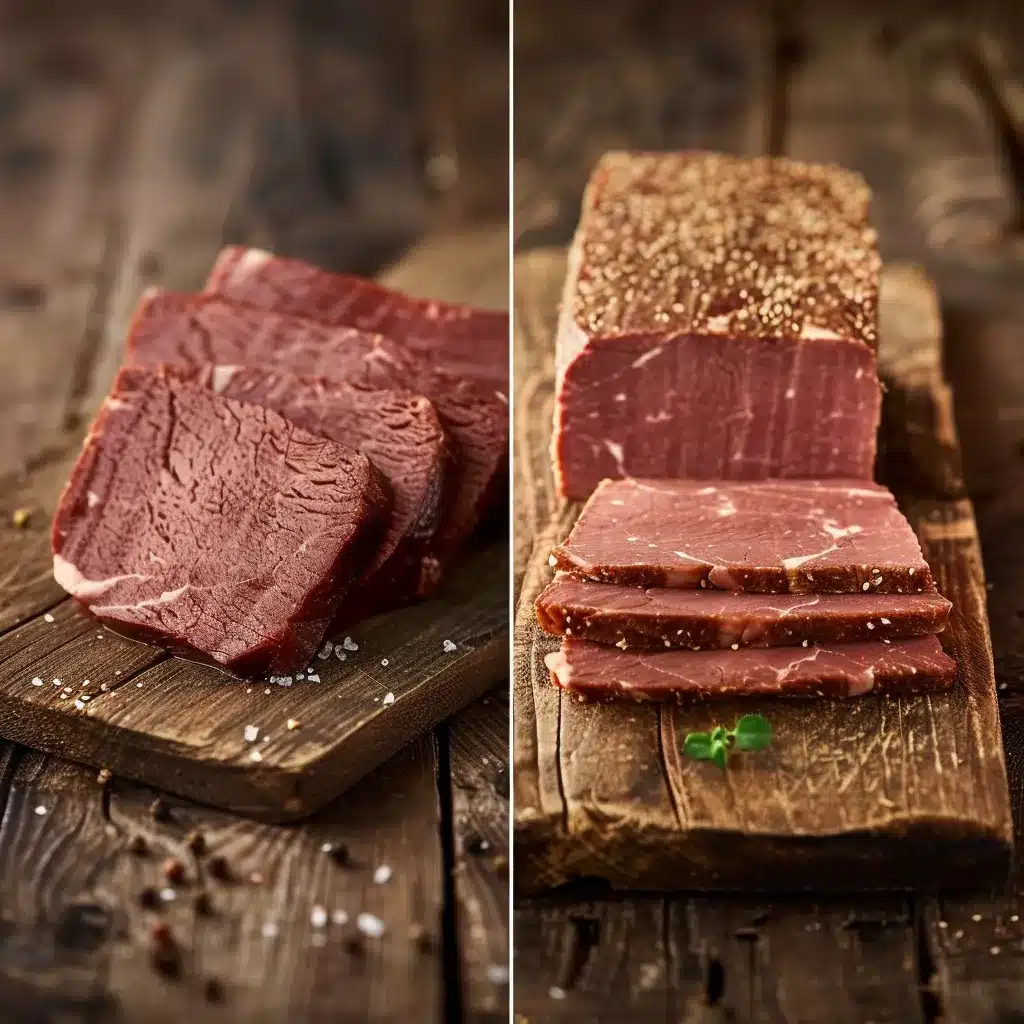
In terms of taste, Angus corned beef tends to have a deeper, more robust flavor. This makes it a better choice for dishes where the beef is the star, such as sandwiches or standalone entrees. On the other hand, regular corned beef works well in recipes where it’s mixed with other strong flavors, like stews or casseroles.
Price-wise, Angus corned beef is usually a bit more expensive due to the higher quality of the meat. However, many people find the extra cost worth it for the improved taste and texture.
Angus Corned Beef vs. Other Cured Meats
This recipe also stands out when compared to other cured meats like pastrami and bresaola. Pastrami, for example, is smoked after curing, giving it a distinct smoky flavor. While delicious, it’s quite different from the tangy, salty taste of Angus corned beef.
Bresaola, on the other hand, is an air-dried, aged beef that’s leaner and often served thinly sliced. It’s a great option for charcuterie boards but lacks the hearty, comforting quality of Angus corned beef. Each of these meats has its place, but Angus corned beef shines in dishes that call for a rich, savory flavor.
Buying and Storing
How to Choose the Best Angus Corned Beef
When shopping for Angus corned beef, there are a few things to keep in mind. First, check the label to ensure it’s made with Angus beef. This guarantees you’re getting a high-quality product. Next, look for a good balance of fat and meat, as this will affect the flavor and tenderness.
You’ll also find both fresh and pre-packaged options. Fresh Angus corned beef is often sold at butcher shops and can be customized with your preferred spice blend. Pre-packaged versions are more convenient and widely available at grocery stores. Either way, make sure the meat looks fresh and has a vibrant color.
Proper Storage Techniques
Once you’ve bought your Angus corned beef, proper storage is key to maintaining its quality. If you’re not cooking it right away, keep it in the refrigerator. Make sure it’s tightly wrapped to prevent it from drying out. Most Angus corned beef can last in the fridge for up to a week.
For longer storage, freezing is a great option. Wrap the meat tightly in plastic wrap and then in aluminum foil to prevent freezer burn. When you’re ready to use it, thaw it in the refrigerator overnight. Avoid thawing at room temperature, as this can affect the texture and safety of the meat.
For more delicious recipes, check out our recipe article on Ground Beef Lunch Meal.
Different Cuisines
Angus Corned Beef in Irish Cuisine
When it comes to Irish cuisine, Angus corned beef plays a starring role, especially during St. Patrick’s Day celebrations. Traditionally, it’s boiled with cabbage, potatoes, and carrots to create a hearty, comforting meal. This dish, often called “corned beef and cabbage,” has become a symbol of Irish-American culture.
The rich flavor of Angus corned beef pairs perfectly with the mild, slightly sweet taste of boiled vegetables. Over time, this classic recipe has evolved, with some cooks adding beer or Guinness to the cooking liquid for extra depth. Whether you’re celebrating a holiday or just craving something cozy, this dish is a must-try.
Global Adaptations of Angus Corned Beef
While Angus corned beef has strong roots in Irish cuisine, it’s also found its way into other culinary traditions. In the United States, it’s a key ingredient in the Reuben sandwich, which combines the beef with sauerkraut, Swiss cheese, and Russian dressing on rye bread. This sandwich is a staple in delis across the country.
In the UK, Angus corned beef is often used in pies and pastries. It’s also popular in parts of Asia, where it’s incorporated into fried rice or noodle dishes. These global adaptations show just how versatile Angus corned beef can be. No matter where you are, there’s a way to enjoy this flavorful meat.
Health Benefits and Concerns
Benefits of Eating the recipe
Angus corned beef offers several health benefits, making it a worthwhile addition to your diet. First, it’s an excellent source of protein, which is essential for building and repairing muscles. It also provides important vitamins like B12, which supports nerve function, and minerals such as zinc and iron, which boost immunity and energy levels.
Additionally, the marbling in Angus beef adds healthy fats that can help keep you full and satisfied. When paired with fresh vegetables or whole grains, Angus corned beef can be part of a balanced, nutritious meal.
Potential Health Concerns
While Angus corned beef has its perks, there are a few things to keep in mind. Due to the curing process, it can be high in sodium, which may not be suitable for those with high blood pressure or heart conditions. To reduce the salt content, you can rinse the meat before cooking or opt for low-sodium versions.
It’s also important to enjoy Angus corned beef in moderation. Pairing it with plenty of vegetables and whole grains can help balance the meal and make it healthier. By being mindful of portion sizes and preparation methods, you can enjoy this delicious dish without compromising your health.
FAQs
What is Angus corned beef?
Angus corned beef is a high-quality version of traditional corned beef, made from Angus beef brisket. It’s cured in a brine solution with salt and spices, giving it a tangy, savory flavor. The use of Angus beef makes it more tender and flavorful compared to regular corned beef.
Is corned beef a good meat to eat?
Yes, corned beef can be a good meat to eat in moderation. It’s rich in protein, vitamins, and minerals like B12, zinc, and iron. However, it’s often high in sodium, so it’s best enjoyed as part of a balanced diet.
Why is Angus beef so special?
Angus beef is known for its superior marbling, which makes it more tender and flavorful than other types of beef. This marbling also helps keep the meat juicy during cooking, making it a favorite among chefs and home cooks alike.
What is the best corned beef to buy?
The best corned beef to buy is one made with high-quality ingredients, such as Angus beef. Look for options with a good balance of fat and meat, and check the label for added preservatives or excessive sodium.
What part of the cow is corned beef?
Corned beef is typically made from the brisket, a cut from the lower chest of the cow. This cut is known for its rich flavor and becomes tender when cooked slowly.
What the heck is corned beef?
Corned beef is a type of cured beef that’s been preserved in a brine solution with salt and spices. The term “corned” refers to the large salt crystals, or “corns,” used in the curing process. It’s a flavorful, versatile meat that’s popular in many cuisines.
Conclusion and Final Thoughts
Why Angus Corned Beef is a Must-Try
Angus corned beef is more than just a meal—it’s an experience. From its rich history to its incredible flavor, this dish has something to offer everyone. Whether you’re cooking it for a holiday feast or a weeknight dinner, it’s sure to impress.
The tenderness and marbling of Angus beef take corned beef to a whole new level. Plus, its versatility means you can use it in everything from classic boiled dinners to creative sandwiches and hash.
Where to Buy Angus Corned Beef
If you’re ready to try Angus corned beef, look for it at your local butcher shop or grocery store. Many brands offer high-quality options, so don’t be afraid to ask for recommendations. You can also find it online, making it easy to enjoy no matter where you live.
In the end, Angus corned beef is a dish that brings people together. So, gather your ingredients, fire up the stove, and get ready to savor every bite.
Looking for more cooking inspiration and helpful tips? Follow me on Facebook and Instagram for daily recipes, cooking tricks, and much more!
Print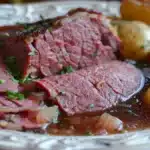
Amazing Angus Corned Beef: A Complete Guide to Recipes, History, and Nutrition
- Total Time: 3 hours 40 minutes
- Yield: One whole corned beef brisket meal
Description
A hearty and flavorful dish, this Classic Boiled Angus Corned Beef with Cabbage is a traditional favorite, especially for St. Patrick’s Day celebrations. Slow-simmered to perfection, the Angus corned beef becomes incredibly tender and pairs beautifully with cabbage, carrots, and potatoes. This one-pot meal is comforting, satisfying, and easy to make!
Ingredients
- 4 lbs Angus corned beef brisket
- 12 cups water (or enough to cover the brisket)
- 2 bay leaves
- 1 tbsp black peppercorns
- 1 tbsp mustard seeds
- 1 tsp whole cloves
- 4 cloves garlic, smashed
- 1 large onion, quartered
- 4 large carrots, peeled and cut into chunks
- 6 medium potatoes, quartered
- 1 medium head of cabbage, cut into wedges
Instructions
- Prepare the Corned Beef: Rinse the Angus corned beef brisket under cold water to remove excess salt from the curing process.
- Simmer the Brisket: Place the brisket in a large pot and add enough water to fully cover it. Add bay leaves, peppercorns, mustard seeds, cloves, garlic, and onion. Bring to a boil, then reduce heat to low and let it simmer for 2.5–3 hours, or until fork-tender.
- Add Vegetables: Once the beef is tender, add the carrots and potatoes. Continue simmering for 20 minutes until they start to soften.
- Cook the Cabbage: Add the cabbage wedges and cook for another 10–15 minutes, until all the vegetables are tender.
- Slice and Serve: Remove the brisket from the pot and let it rest for 10 minutes before slicing against the grain. Serve with the cooked vegetables and some of the flavorful broth.
Notes
- For extra flavor, add a bottle of Guinness beer or beef broth to the simmering liquid.
- Leftovers make amazing corned beef hash for breakfast!
- Serve with a side of horseradish sauce or grainy mustard for an extra kick.
- Prep Time: 10 minutes
- Cook Time: 3 hours 30 minutes
- Cuisine: Irish-American
Nutrition
- Serving Size: 6 servings
- Calories: ~450
- Sodium: High (varies based on rinsing and brand)
- Fat: 22g
- Carbohydrates: 30g
- Protein: 35g

